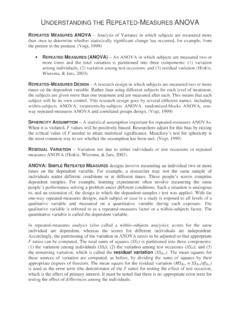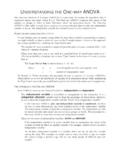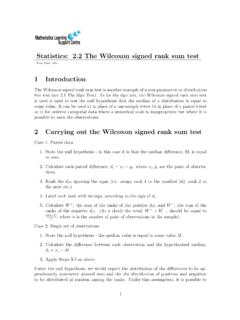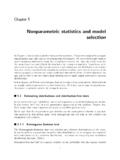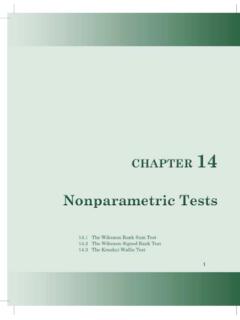Transcription of The Friedman Test - oak.ucc.nau.edu
1 EPS 625 INTERMEDIATE STATISTICS Friedman TEST The Friedman test is an extension of the wilcoxon test. The wilcoxon test can be applied to repeated-measures data if participants are assessed on two occasions or conditions or matched-subjects data if participants are matched in pairs. In contrast, the Friedman test allows for the analysis of repeated-measures data if participants are assessed on two or more occasions or conditions or to matched-subjects data if participants are matched in pairs, triplets, or in some greater number. The Friedman test is applicable to problems with repeated-measures designs or matched-subjects designs. With repeated-measures designs, each participant is a case in the SPSS data file and has scores on K variables, the score obtained on each of the K occasions or conditions.
2 A researcher is interested in determining if subjects changed significantly across occasions (or conditions). For a matched-subjects design , participants are matched in sets of K participants, and each participant in a set is assessed once on a measure. Each set of participants is a case in the SPSS data file and has scores on K variables, the scores obtained on the measure by the participants within a set. If the independent variable has only two occasions or conditions, no additional significance tests need to be conducted beyond the Friedman test. However, if a factor has more than two occasions or conditions and the overall test is significant, follow-up tests are usually conducted.
3 These follow-up tests most frequently involve comparisons between pairs of group medians. For the Friedman test, we could use the wilcoxon test to examine unique pairs. UNDERSTANDING THE Friedman TEST For the Friedman test, the observations come in sets of K observations. Within a set, the observations are dependent, but between sets the observations are independent. For the Friedman test, the dependent variable must be measured on at least an ordinal scale, and the null hypothesis states that the population medians are equal for the K levels of a factor. The parametric alternative to the Friedman test is the one-way repeated-measures analysis of variance (RM-ANOVA). For either test, analyses involve a factor with K levels, and we are interested in evaluating whether scores differ significantly across the levels of the factor.
4 The tests take into account the dependency among scores introduced by the repeated-measures or matched-subjects characteristics of the design . To help understand how the Friedman test evaluates differences in medians among conditions, we will look at an example provided by Green and Salkind (2008). First, we must describe what data are being analyzed in this test. We will be using an example dealing with concerns for job pay, climate, and security to demonstrate the Friedman test (Lesson 45 from Green & Salkind). For this example: Pay is defined as concern for job pay on a rating scale from 1, indicating no concern, to 10, indicating ultimate concern; Climate is defined as concern for job climate on a rating scale from 1, indicating no concern, to 10, indicating ultimate concern; and Security, which is defined as concern for job security on a rating scale from 1, indicating no concern, to 10, indicating ultimate concern.
5 Friedman TEST PAGE 2 ASSUMPTIONS UNDERLYING A Friedman TEST Assumption 1: Each set of K observations must represent a random sample from a population and must be independent of every other set of K observations. If the data are from a repeated-measures design , the scores for each participant must be independent of the scores from any other participant. If the data are from a matched-subjects design , the sets of scores from any matched set of participants must be independent of the scores of any other matched set of participants. If the independence assumption is violated, the test is likely to yield inaccurate results. It should be noted that the analysis permits dependency among scores within a set.
6 Assumption 2: The Chi-Square values for the Friedman test yield relatively accurate results to the extent that the sample size is large. The results for the tests should be fairly accurate if the sample size is 30 or greater. Assumption 3: The Distribution of the differences scores between any pair of levels is continuous and symmetrical in the population. This assumption is required to avoid ties and to ensure that the test evaluates difference in medians rather than other characteristics of the distribution. Friedman TEST PAGE 3 EFFECT SIZE STATISTICS FOR THE Friedman TEST SPSS computes Kendall s coefficient of concordance (Kendall s W), a strength-of-relationship index. The coefficient of concordance ranges from 0 to 1, with higher values indicating a stronger relationship.
7 THE RESEARCH QUESTION The research question used in this example is asked to reflect differences in medians between conditions. Do employees medians on concern for job pay, job climate, and job security ratings differ in the population? CONDUCTING THE K RELATED-SAMPLES ( Friedman ) TEST IN SPSS To conduct the Friedman test and follow-up tests using the wilcoxon test in SPSS, use the following steps: Open the dataset in SPSS to be used for the Friedman Test analysis Click Analyze, click (mouse over) Nonparametric Tests, and then click K Related o You should now be in the Test for Several Related Samples dialog box Click Pay, then holding down the Ctrl key, click Climate, and Security, and click to move them to the Test Variables.
8 Box Under Test Type be sure that Friedman is selected [ ] this should be the default Under Test Type select [ ] Kendall s W Click Statistics Select [ ] Descriptive Click Continue Click OK You are now ready to analyze the output Friedman TEST PAGE 4 SPSS OUTPUT NPar Tests Descriptive DeviationMinimumMaximum Friedman Test rank Test Testa. Kendall's W Test rank Test 's WaChi-SquaredfAsymp. 's Coefficient of Concordancea. Friedman TEST PAGE 5 The Friedman test, which evaluated differences in medians among the three job concerns, is significant c2(2, N = 30) = , p < .01. Kendall s W is .23, indicating fairly strong differences among the three concerns. Next, follow-up tests will need to be conducted to evaluate comparisons between pairs of medians.
9 As indicated earlier, we will use the wilcoxon test. CONDUCTING PAIRWISE COMPARISONS AFTER OBTAINING A SIGNIFICANT Friedman TEST IN SPSS To conduct the wilcoxon test in SPSS, use the following steps: Click Analyze, click (mouse over) Nonparametric Tests, and then click 2 Related o You should now be in the Two-Related Samples Tests dialog box Holding down the Ctrl key, click Pay and Climate, and click to move them to the Test Pair(s) List: box Holding down the Ctrl key, click Pay and Security, and click to move them to the Test Pair(s) List: box Holding down the Ctrl key, click Climate and Security, and click to move them to the Test Pair(s) List: box Under Test Type be sure that wilcoxon is selected [ ] this should be the default Click Options Under Statistics o Select [ ] Descriptive Click Continue Click OK You are now ready to analyze the output SPSS OUTPUT NPar Tests Descriptive DeviationMinimumMaximum Friedman TEST PAGE 6 wilcoxon Signed Ranks Test RanksPositive RanksTiesTotalNegative RanksPositive RanksTiesTotalNegative RanksPositive RanksTiesTotalClimate - PaySecurity - PaySecurity - ClimateNMean RankSum of RanksClimate < Paya.
10 Climate > Payb. Climate = Payc. Security < Payd. Security > Paye. Security = Payf. Security < Climateg. Security > Climateh. Security = Climatei. Test Sig. (2-tailed)Climate - PaySecurity - PaySecurity -ClimateBased on positive Based on negative wilcoxon Signed Ranks Testc. The Least Significant Difference (LSD) procedure controls adequately for Type I error across pairwise comparisons if there are three levels and the overall test is significant. In our example, two of three comparisons (Climate-Pay and Security-Pay) were significant at the .05 alpha level. If the number of levels exceeds three, then the Bonferroni or Holm s Sequential Bonferroni method would be required to control adequately for Type I error.

